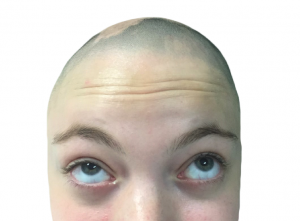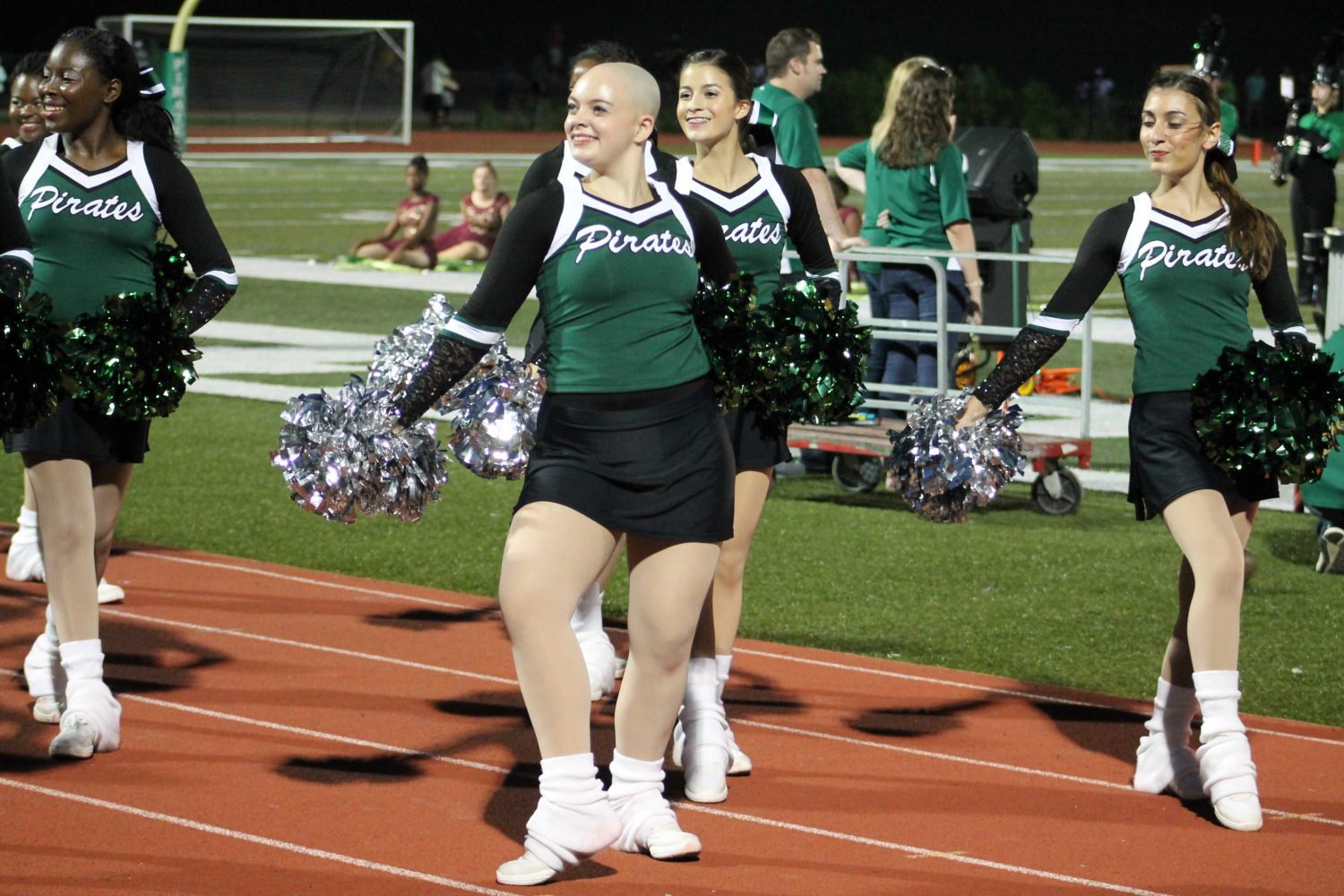DiSalvo has alopecia areata, is feeling free without her wig
September 13, 2016

Junior Isabel DiSalvo started dancing at the age of 10 but that’s not why she is easily spotted when performing with the Varsity Drill Team. DiSalvo was diagnosed with alopecia areata, an incurable form of hair loss.
DiSalvo first noticed the loss of her hair when she was getting ready to go to the first varsity football game her freshman year. She was doing her hair and noticed a chunk of hair missing. Immediately she freaked out but eventually covered it up and went on to the game.
When DiSalvo returned, her parents told her that they believed that she had alopecia, and her world crumbled.
DiSalvo was aware of the condition as a teacher at her middle school, Mr. Michael Winship, also had alopecia.
“I am always very open with my students about the alopecia,” Winship said. “I’ve had it so long that I don’t really think about it anymore to be honest, but we have had enough students come through Heights with the condition that I try to be very good about sharing why I shave my head. I’ve also had students mistakenly believe I have cancer, so I try to avoid that concern from the get-go.”
DiSalvo has also had this happen to her. She has found out that a lot of people have no idea what alopecia is or anything about it.
“People asked me all of the time if I had cancer just because that’s what a lot of people relate kids not having hair to, but I’m not sick or dying, I just have alopecia,” DiSalvo said.
[MORE]
[portfolio_slideshow id=18868]
DiSalvo first worried about not having hair by the end of that week, but as she researched alopecia areata, she found that it doesn’t always happen that rapidly.
A doctor later confirmed the suspicion that she had alopecia. DiSalvo continued to lose hair more and more often throughout freshman year. She used makeup to cover the bald spots and wore her hair in a ponytail, living in constant fear that someone would notice. Stress only increased the condition. DiSalvo would sit in class and look over and see a clump of her hair just sitting on her shoulder.
Sophomore year brought lots of new changes for DiSalvo. She started wearing a wig, despite still having some hair. As more and more hair fell out, she started to get annoyed having to spend an extra 30 minutes adjusting her wig and pinning it in each morning.
DiSalvo joined the JV drill team that year and practice and performances were not enjoyable to say the least.
“At the Lindbergh competition, I remember doing a straddle at the beginning of the dance and I felt my wig move. The rest of the dance I was so worried that it would fall off that I couldn’t even focus on the performance,” DiSalvo said.
She said that she would leave practice upset every day because the wig she was wearing made her feel sick and hot and uncomfortable.
In the spring of her sophomore year, DiSalvo was asked to participate in a photo shoot along with other kids who had alopecia. DiSalvo accepted the offer and traveled to Chicago with her mom to partake in the event.
“When we went to start taking pictures, I noticed that I was the only one who was wearing a wig and I didn’t like that.”
DiSalvo didn’t want to be the only one wearing a wig for the shoot and so she ditched the wig for the weekend.
“It was the first time I went out in public without my wig on. I wore a hat because I wasn’t ready to go completely bald,” DiSalvo said.
The trip was very empowering for DiSalvo and changed her mindset completely on the idea of going without a wig.
When she got home, DiSalvo continued to wear the wig until the end of the school year.
“I was afraid that it would freak people out too much if I had what they thought was my hair on Friday and then show up Monday without hair,” DiSalvo said.
Once summer hit though, DiSalvo decided that she wouldn’t wear the wig anymore no matter where she was.
“I was happy and comfortable without it, so why would I wear it?”
DiSalvo doesn’t shy away from the chance to tell people about the condition. She will tell her story to anyone who asks or wants to know about it.
“Anytime anyone asks about it, I tell them the truth and try to answer any questions they have to ask. It doesn’t bother me at all. I like being able to tell people about it,” DiSalvo said.
[box]Alopecia Areata
*Affects more adults in their 20s to 60s
*Treatable, but not curable
*Can cause hair loss from all parts of body and not just the head
*Can cause symptoms such as: itching, anxiety, and dents in nails along with the hair loss
*The cause is unknown
*The condition is not contagious[/box]
This year, DiSalvo has had to educate 17 more girls as she is on the Varsity Drill Team. DiSalvo has appeared in front of large groups of people at many different events because of this and has chosen to not wear her wig while she performs.
“I didn’t know anything about the condition when she first made the team,” teammate Emily Reyes said, “but I knew that it didn’t affect the way she acted during practice. Actually, she was super cheerful and supportive. If she hadn’t shaved her head, I wouldn’t have known anything was wrong.”
DiSalvo is now just another member of the Varsity Drill Team.
“It’s a complete 180 from dancing with the wig. I am so much more comfortable now and way less stressed out.”
DiSalvo doesn’t let the fact she doesn’t have hair deter her from smiling big and dancing even bigger. She doesn’t care if it makes her stand out.
“I hope that by sharing my story with others it can help others who have this condition and also help other people learn more about the condition.”


